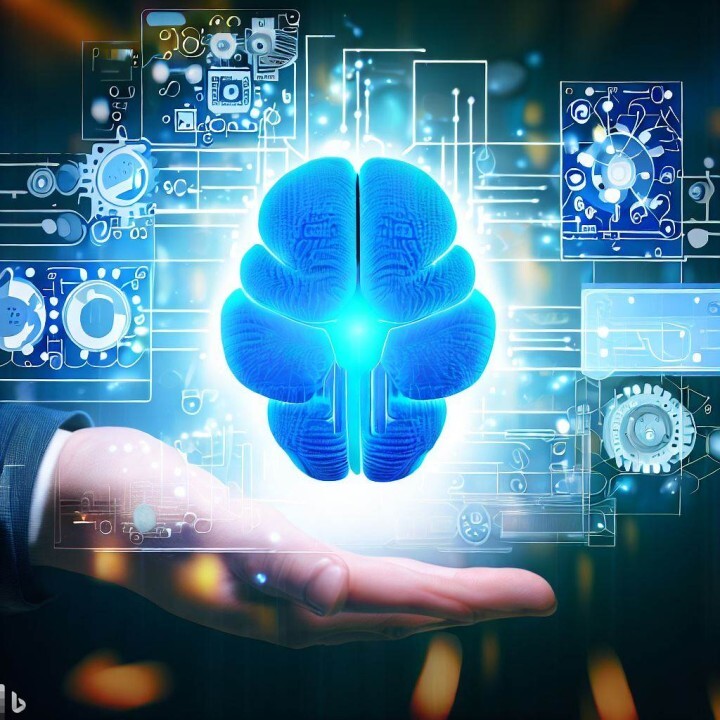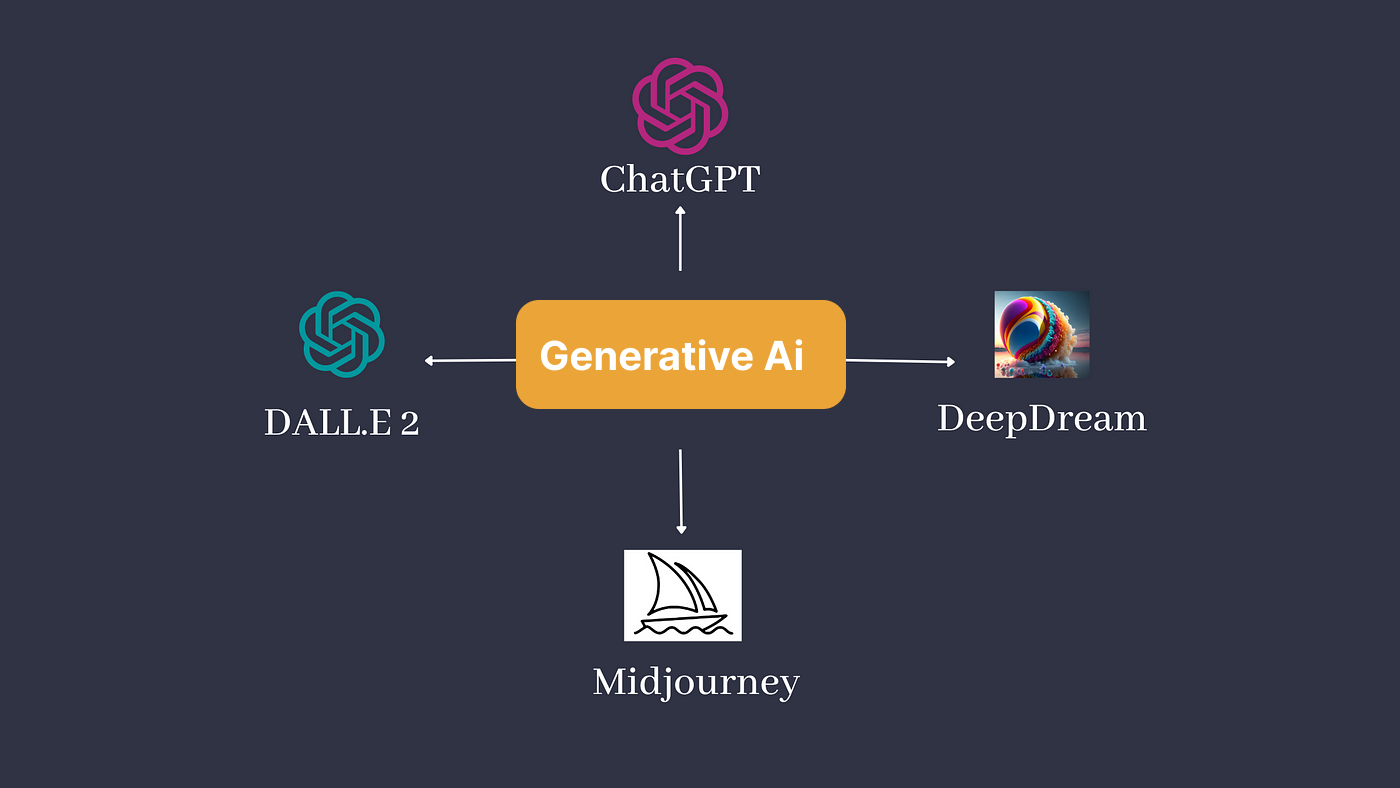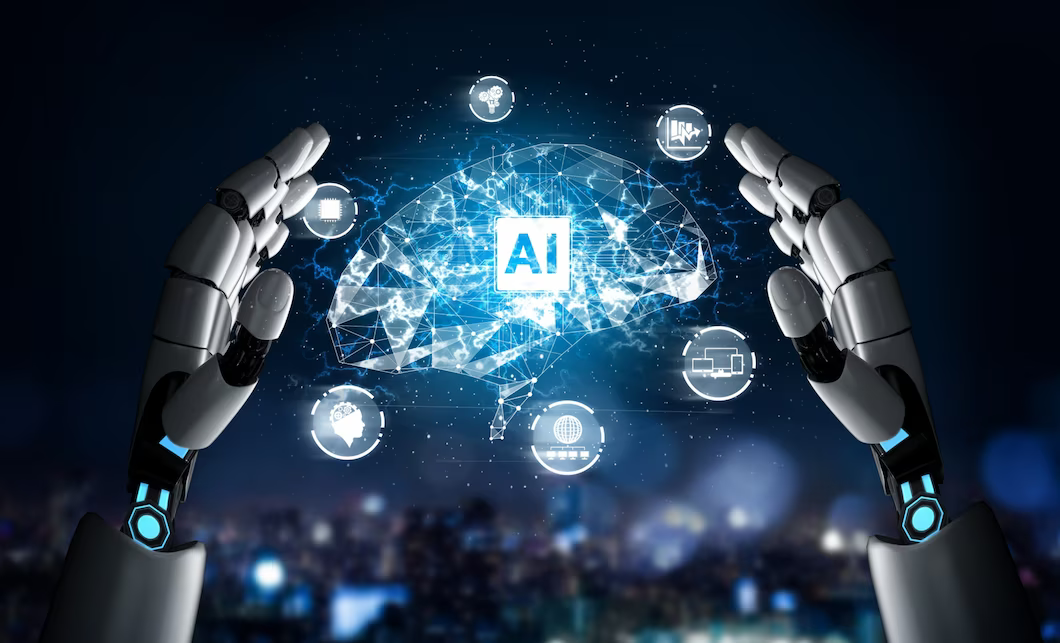There has been a lot of discussion and buzz around Generative AI in 2023. It has gained rapid traction amongst consumers, businesses, and professionals. So you might be wondering what it is, how it works and what’s all the hype about?
This blog will discover everything you need to know about Generative AI. From its working principles to AI models and real-world applications, we have got you covered.
Read on to find out more.
What is Generative AI?
Generative AI is a type of artificial intelligence that allows users to produce content based on a variety of commands or inputs.
It can produce a variety of content such as audio, text, code, video, images, and other data.
It should be noted that the technology is not new. Initially, chatbots used generative AI as a form of artificial intelligence in the 1960s.
However, it wasn’t until 2014 that generative AI was able to create convincingly authentic videos and audio of people, thanks to generative adversarial networks, a type of machine learning algorithm.
The application of generative AI encompasses a wide variety of fields, including art, image synthesis, natural language generation, coding, and many more.
Rather than using traditional AI algorithms to identify patterns within training data sets and predict outcomes, generative AI uses machine learning algorithms to create outputs.
The majority of traditional forms of artificial intelligence, such as discriminative AI, are designed to classify or categorize existing information. Generative AI, on the other hand, strives to generate completely original artifacts.
The output of generative AI can be in the same medium as the input (e.g., text-to-text), or it can be in another medium (like text-to-image or image-to-video).
Among the most prominent examples of generative AI are ChatGPT, Bard, DALL-E, Midjourney, and DeepMind.
How does generative AI work?
Generative AI uses various machine learning techniques and neural networks to learn patterns within the existing data and then use this knowledge to generate new content.
AI system processes the inputs given to it in the form of Prompts that could be a text, an image, a video, a design, musical notes, or any input.
Early versions of generative AI required submitting data via an API or an otherwise complicated process. Developers had to familiarize themselves with special tools and write applications using languages such as Python.
Now, pioneers in generative AI are developing better user experiences that let you describe a request in plain language.
After an initial response, you can also customize the results with feedback about the style, tone, and other elements you want the generated content to reflect.
Types of generative AI models
Various types of generative AI models exist, each designed for a specific task. In general, these are categorized as follows.
Multimodal models
Multi-modal models are able to understand and process text, images, and audio simultaneously, so they can generate more sophisticated results.
One example might be a model that generates images based on text prompts, along with description text for the image prompt. The best examples of multimodels are Bard and ChatGPT.

Transformer-based models
Transformer-based models are based on deep learning and learn from large sets of data how to connect sequential information, such as words and sentences.
They are adept at understanding language structure and context, thus making them ideal for text generation.
Among the transformer-based generative AI models are ChatGPT-3 and Google Bard.
Variational autoencoders
A VAE is comprised of two networks: an encoder and a decoder that interpret and generate data. Encoding compresses the input data into a simpler format. Decoders then reassemble compressed information into new information that resembles the original but isn’t the same.
For example, using photos as training data, a computer program can generate human faces.
Through repeated use, the program learns how to simplify pictures of people’s faces into important characteristics, such as their eyes, nose, mouth, ears, and so on.
Generative adversarial networks
The GAN consists of two neural networks — a generator and a discriminator — that work against one another to create authentic-looking data.
Based on a prompt, the generator generates convincing output such as an image, whereas the discriminator evaluates its authenticity.
Each component improves over time, resulting in more persuasive outcomes. GAN-based generative AI models can be found in both DALL-E and Midjourney.
What ChatGPT, Bard and Dall-E?
ChatGPT, Dall-E, and Bard are popular generative AI interfaces. Let’s have a quick look at each of them.
ChatGPT
A chatbot powered by artificial intelligence (AI) brought the world to its knees in November 2022 and was built using OpenAI’s implementation of GPT-3.5.
An OpenAI chat interface with interactive feedback provides a way for users to interact and fine-tune text responses. In the past, GPT was only accessible via an API.
In 2023, GPT-4 will be released. With ChatGPT, you can simulate a real conversation by using the history of your conversation with the user.
The tremendous popularity of the new GPT interface led Microsoft to announce that it would invest significantly in OpenAI and would use a GPT-based version of Bing.

Dall-E
Dall-E, trained on images and their texts, is an AI application that recognizes links between multiple media, such as vision, text, and audio.
Using the GPT implementation from OpenAI, it was created in 2021. In 2022, Dall-E 2 was released, a more capable version.
Dall-E uses small language models (LLMs), large language models (NLP), and diffusion processes to process text. It generates imagery in multiple styles based on the prompts provided to the user.
Bard
It is a creative writing assistant whose functions include generating stories, poems, essays, songs, and more. The language is based on GPT-3, but with some additions and modifications to make it more creative and expressive.
There are many genres, styles, formats, and tones that Bard can write in. Furthermore, it provides feedback, suggestions, and rewriting options to help you improve your writing skills.
As of now, Bard cannot write code, or respond to queries about code, unlike ChatGPT. As the service learns to program, many opportunities will open up for developers and programmers.
What are the Applications of Generative AI?
Artificial intelligence is a powerful tool for streamlining the workflow of creative professionals, engineers, researchers, and scientists alike. All industries and individuals can benefit from the use cases and possibilities.
AI models can generate content in any of the forms mentioned above from inputs like text, image, audio, video, and code.

The program can transform text inputs into images, convert images into songs, or convert videos into text. The following are the most popular generative AI applications:
Visual:
It is no secret that generative AI is popular in the realm of images. Creating 3D images, avatars, videos, graphs, and other illustrations falls into this category.
Images can be generated with different aesthetic styles, and edited or modified using different techniques.
Generative AI models can generate the following types of images:
- Graphs showing new chemical compounds and molecules that aid in drug discovery.
- Realistic images for virtual or augmented reality.
- 3D models for video games.
- Design logos.
- Enhance or edit existing images, and more.
Language:
In many generative AI models, text is the foundation and is considered the most advanced component.
Generic language models are one of the most popular examples of language-based generative models. They are known as large language models (LLMs).
Various tasks can be performed using large language models, including essay writing, code development, translation, and even genetic sequence analysis.
Audio:
Generative AI is also advancing in fields such as music, audio, and speech. Some models can create songs, and snippets of audio clips accompanied by text inputs, customize music, and even recognize objects in videos and create accompanying noises.
Synthetic data:
When data is unavailable, restricted, or cannot adequately address corner cases, synthetic data can be extremely useful for training AI models.
Developing synthetic data through generative models is one of the most impactful ways to overcome many enterprises’ data challenges. The process involves label-efficient learning, which applies to all modalities and use cases.
The use of generative AI models can reduce labeling costs either by generating additional augmented training data or by learning an internal representation of data.
Generative models are profoundly changing the way we think, and their applications are growing all the time.
Applications of Generative AI by Industry
As generative AI technology and our understanding of it continue to develop, industries are utilizing it in a variety of ways.
There are many applications across multiple fields today, some of which include:
Natural sciences:
There are many benefits associated with generative AI for the field of natural sciences.
In the healthcare industry, generative models help in the following areas:
- Discovery of new drugs by developing a new protein sequence.
- It helps predict the effects of a drug on a certain disease.
- In addition, they can be used to identify new uses for existing drugs.
- Automation can also assist practitioners with tasks such as scribing, medical coding, imaging, and genomic analysis.
Climate and Environment:
Weather forecasts and natural disaster predictions can be made more accurate with the help of generative models. Generative models are capable of learning complex patterns from large amounts of data which can be used to:
- Identify patterns in weather data that can be used to predict future weather patterns.
- Develop models for predicting natural disasters, such as earthquakes and hurricanes.
- Assess data to identify potential hazards and develop mitigation strategies.
- Make evacuation plans or emergency preparedness recommendations to help mitigate the effects of a natural disaster.
Applications like these can help to create safer environments for the general population and allow scientists to better prepare for natural disasters.
Entertainment:
A wide range of entertainment industries can utilize generative AI models for content creation, including video games, film, animation, and virtual reality. Creators use generic models as a tool to enhance their creativity.
AI models can be used to rapidly generate large volumes of content, allowing creators to produce a wide range of content efficiently and quickly.
They can also benefit from AI models by using them to provide insights and recommendations. Plus, AI models help to generate new ideas, allowing creators to explore new creative directions.
Automotive Industry:
The automotive industry expects generative AI to help create virtual worlds and models to aid in simulations and designing cars. A synthetic data-based training method is also being used to train autonomous vehicles.
The ability to road-test autonomous vehicles in a realistic 3D environment increases safety, efficiency, and flexibility while reducing risk and overhead.
The following are the benefits of testing in a controlled environment:
- It helps to identify any potential issues early in the process before the vehicle is released for public use.
- It reduces the time and costs associated with recalls and other repairs.
- The ability to test in a 3D environment allows for more accurate simulations and scenario testing than would otherwise be possible.
Education:
The use of artificial intelligence in the education industry can supplement classroom learning by providing one-to-one tutoring via a chatbot or by creating course materials, lesson plans, or online learning platforms.
Some other applications of generative AI in the education sector include:
- Analyzing student data in order to identify their strengths and weaknesses.
- Informing personalized instruction, and generating insights that can be used to inform policy decisions.
- It can also help to inform decisions about resource allocation and recruitment.
Additionally, students can benefit from personalized digital learning experiences created with AI-driven technologies such as natural language processing and computer vision.
What are the Benefits of Generative AI?
There are several reasons why generative AI is important. Generative AI has the following key benefits:
- By using this technology, one can create unique, original content like images, videos, and texts, very similar to content created by humans. The creation of content in this way can be useful for applications such as entertainment, advertising, and the arts.
- This technology improves the accuracy and efficiency of existing AI systems, such as natural language processing and computer vision. By using generative AI, we can create synthetic data that can be used to test and train other AI algorithms.
- In addition to exploring and analyzing complex data in new ways, AI algorithms can uncover hidden patterns and trends that are not apparent from raw data.
- Businesses and organizations can save time and resources by automating and accelerating a number of tasks and processes.
As a whole, generative AI has the potential to significantly impact a variety of industries and applications and is an important area of research and development in the field of artificial intelligence.
What are the Challenges of Generative AI?
Considering generative models as an evolving space, there is still room for growth in the following areas.
- Lack of high-quality data:
Various applications use generative AI models to generate synthetic data. It is true that there are troves of data generated daily around the world, but not all of it is suitable for training AI models.
To operate, generative models need high-quality, unbiased data. In addition, some domains lack enough data to train a model. For instance, few 3D assets are available and they’re expensive to develop.
The development and maturation of such areas will require significant resources.
- The scale of compute infrastructure:
The training of generative AI models requires fast and efficient data pipelines because they can boast billions of parameters.
A large-scale compute infrastructure as well as significant capital investment are necessary for maintaining and developing generative models.
The training of diffusion models could require millions or billions of images. Additionally, AI practitioners must be able to procure and utilize hundreds of GPUs in order to train their models from such large datasets.
- Data licenses:
In addition to the lack of high-quality data, many organizations experience difficulties getting a commercial license for the use of existing datasets or creating bespoke datasets for training generative models.
It is crucial to avoid intellectual property infringement issues if this process is followed correctly.
In order to solve these problems, companies like NVIDIA, Cohere, and Microsoft are developing services and tools to support the continued growth and development of generative AI models.
By abstracting the complexity of setting up and running models at scale, these products and platforms simplify the process.
- Sampling speed:
There may be some latency in the amount of time it takes to generate an instance because of the scale of generative models.
In interactive applications such as chatbots, AI voice assistants, and customer service applications, conversations need to occur immediately and accurately.
Due to their high-quality samples, diffusion models have become increasingly popular, but their slow sampling speeds have become more apparent.
Who are the major tech providers in the generative AI market?
Generative AI has been booming recently. In addition to the big platform players, there are hundreds of specialty providers funded by venture capital and new open-source capabilities.
Several enterprise software providers, including Salesforce and SAP, have built LLM capabilities into their platforms.
To build the foundational models that support services like ChatGPT and others, companies like Microsoft, Google, Amazon Web Services (AWS), and IBM have invested hundreds of millions of dollars and massive computing power.
We consider the current major players to be as follows:
In addition to Palm, Google has a pure language model, Bard, which is a multimodal model. With their generative AI technology embedded in their suite of workplace applications, millions of people will be able to access it immediately.
- IBM:
By injecting data and retraining and employing the model, IBM has multiple foundation models and can fine-tune both its own and third-party models.
- Amazon:
Several LLMs are available on an open-source basis from Hugging Face through Amazon’s partnership. Besides Bedrock, Amazon has announced plans for Titan, a set of two AI models that create text and improve search and personalization
- Microsoft and OpenAI:
There is a lockstep between Microsoft and OpenAI. Microsoft is embedding generative AI technology into its products, but it has the first-mover advantage and buzz of ChatGPT.
To Sum Up,
Generative AI is an exciting new technology with endless potential that will transform the way we live and work.
It has traditionally been the domain of data scientists, engineers, and experts, but now that we can prompt software in plain language and generate new content in minutes, AI is becoming accessible to a much wider audience.
However, when it comes to the applications of any technology, there are a variety of concerns and issues to take into consideration.
As generative AI continues to be adopted and developed, various implications will arise, ranging from legal, ethical, and political to ecological, social, and economic.



